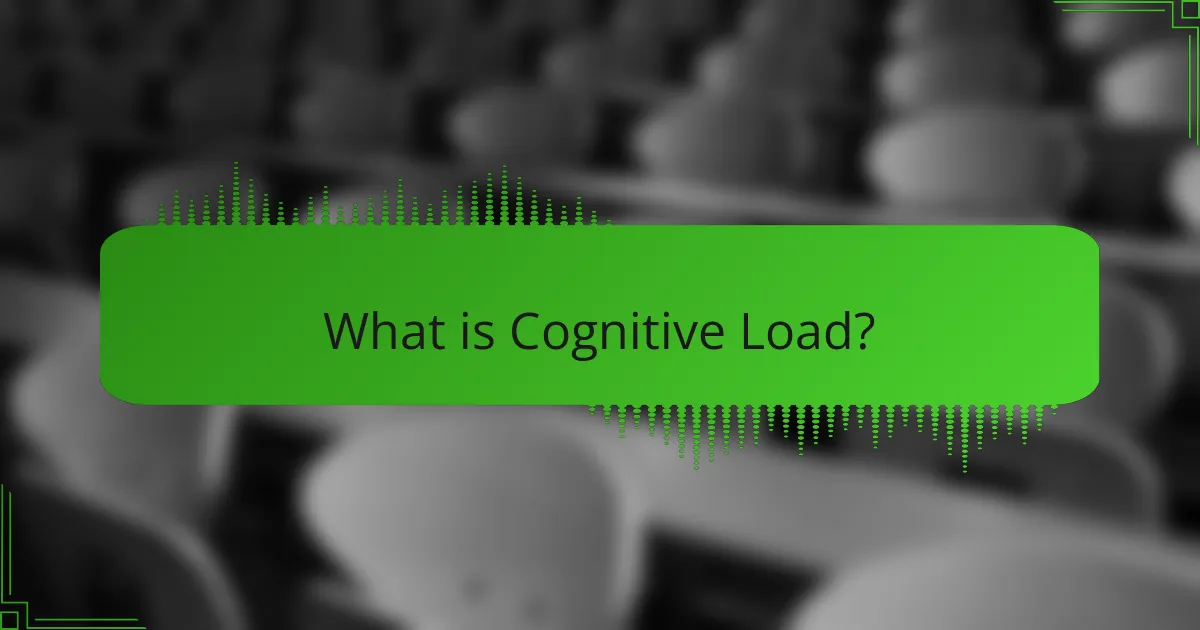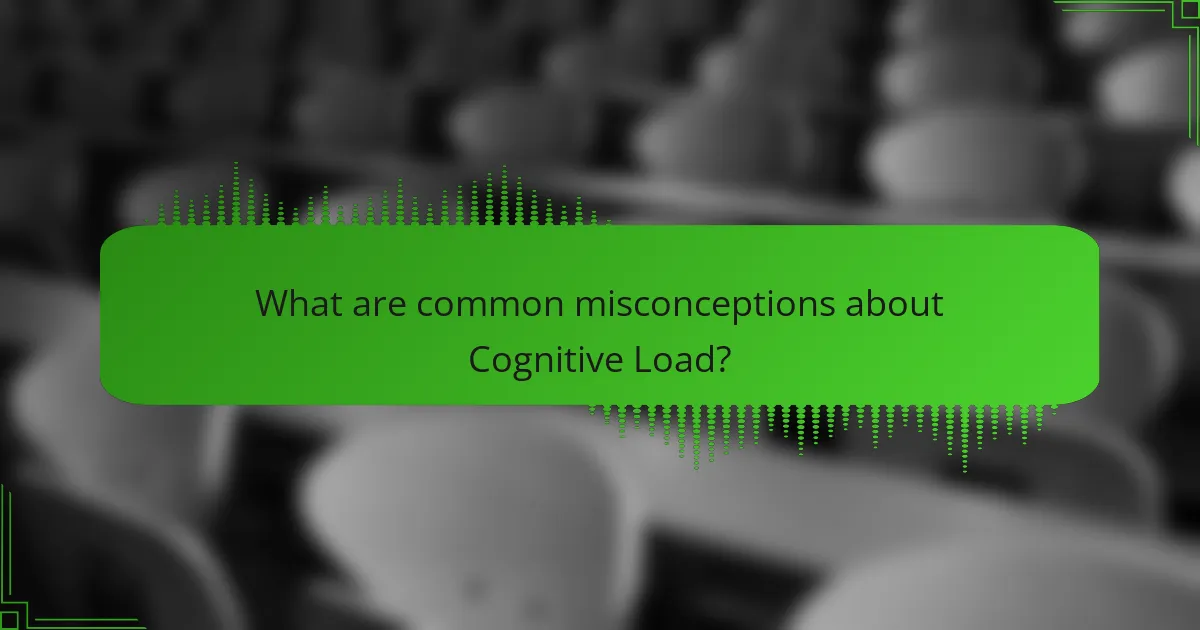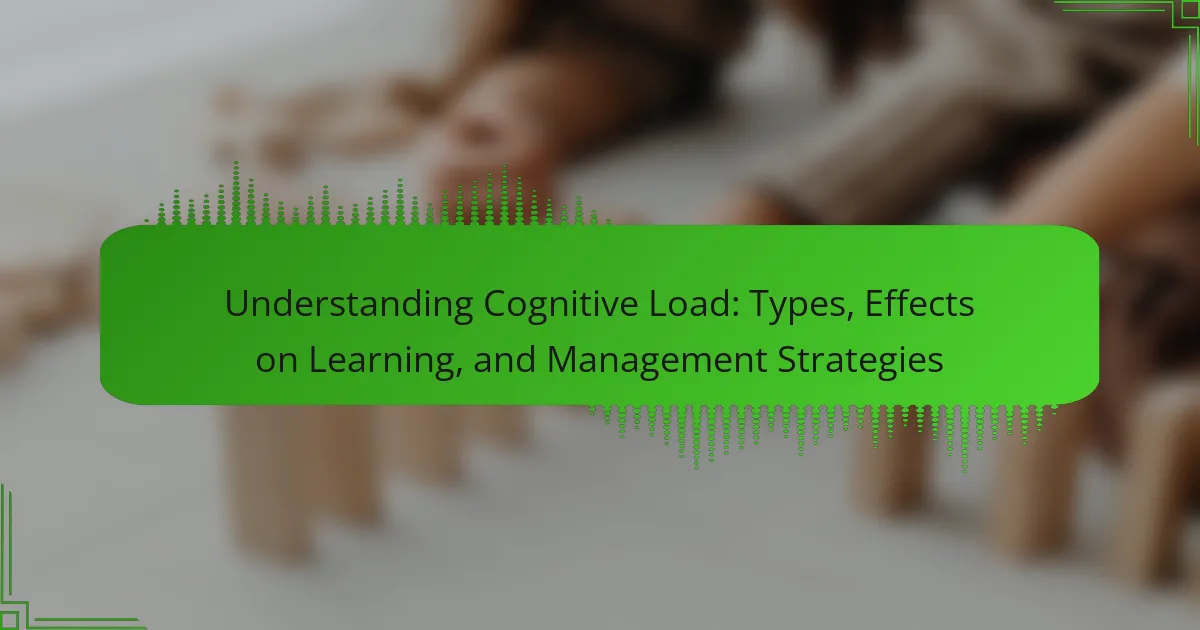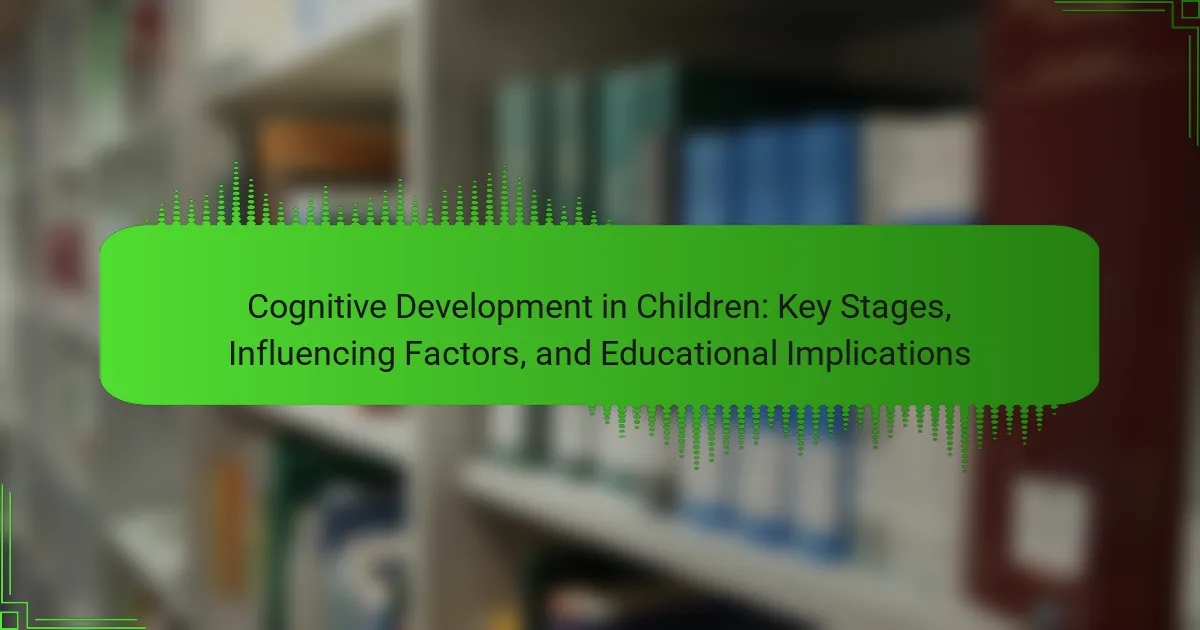Cognitive load refers to the mental effort utilized in working memory during the learning process. This concept, rooted in cognitive psychology, categorizes cognitive load into three types: intrinsic load, which pertains to the complexity of the material; extraneous load, which relates to how information is presented and can impede learning; and germane load, which involves the effort to process and comprehend the material. The article explores the impact of cognitive load on learning outcomes, emphasizing the importance of managing cognitive load to enhance educational practices and user interface design. It discusses practical applications in educational settings, software development, and training programs, highlighting research that supports effective strategies for optimizing cognitive load to improve retention and comprehension.

What is Cognitive Load?
Cognitive load refers to the amount of mental effort being used in the working memory. It is a concept from cognitive psychology that explains how information processing affects learning. Cognitive load can be divided into three types: intrinsic, extraneous, and germane. Intrinsic load is related to the complexity of the material being learned. Extraneous load refers to how information is presented and can hinder learning. Germane load is the effort used to process and understand the material. Research shows that high cognitive load can negatively impact learning outcomes. Managing cognitive load effectively can enhance the learning experience and improve retention.
How is Cognitive Load defined in the context of learning?
Cognitive load is defined as the total amount of mental effort being used in working memory during learning. It affects how information is processed and retained. High cognitive load can hinder learning by overwhelming the learner’s capacity to absorb new information. Conversely, optimal cognitive load facilitates effective learning by balancing the complexity of the material with the learner’s ability to understand it. Research by Sweller (1988) emphasizes the importance of managing cognitive load to enhance educational outcomes. This management can involve breaking information into smaller chunks and using instructional techniques that align with cognitive processing capabilities.
What are the key components of Cognitive Load theory?
Cognitive Load theory consists of three key components: intrinsic load, extraneous load, and germane load. Intrinsic load refers to the complexity of the material being learned and the learner’s prior knowledge. Extraneous load involves the way information is presented, which can hinder or help learning. Germane load relates to the mental effort dedicated to processing and understanding the material. These components help educators design effective learning experiences. Research by Sweller (1988) supports the importance of managing these loads to enhance learning efficiency.
How does Cognitive Load influence the learning process?
Cognitive load influences the learning process by affecting how information is processed and retained. High cognitive load can overwhelm learners, leading to decreased understanding and retention. This occurs when the demands of a task exceed the learner’s cognitive capacity. Research by Sweller (1988) indicates that excessive cognitive load can hinder problem-solving abilities. Conversely, optimal cognitive load enhances learning by allowing for effective information processing. This balance is crucial for successful educational outcomes. Managing cognitive load through strategies like chunking can improve learning efficiency and retention.
What are the different types of Cognitive Load?
There are three different types of cognitive load: intrinsic, extraneous, and germane. Intrinsic cognitive load refers to the complexity of the material being learned. It is influenced by the learner’s prior knowledge and the inherent difficulty of the content. Extraneous cognitive load is related to the way information is presented. Poor instructional design can increase this load and hinder learning. Germane cognitive load pertains to the mental effort dedicated to processing and understanding information. This type of load is beneficial as it promotes the construction of schemas. Research by Sweller (1988) highlights these distinctions, emphasizing their impact on learning efficiency.
What is intrinsic load and how does it affect learning?
Intrinsic load refers to the inherent difficulty associated with a specific learning task. It is determined by the complexity of the material and the learner’s prior knowledge. Higher intrinsic load can hinder learning if the material exceeds the learner’s cognitive capacity. Conversely, a manageable intrinsic load facilitates understanding and retention. Research indicates that when intrinsic load aligns with a learner’s capabilities, it enhances engagement and promotes effective learning strategies. Therefore, understanding intrinsic load is critical for designing educational experiences that optimize learning outcomes.
What is extraneous load and why is it important to minimize?
Extraneous load refers to the unnecessary cognitive effort required to process information that does not contribute to learning. This type of load can arise from poorly designed instructional materials or irrelevant information. Minimizing extraneous load is crucial because it allows learners to allocate more cognitive resources to essential information. Research shows that reducing extraneous load can enhance comprehension and retention of material. For instance, studies indicate that learners perform better when instructional design aligns with cognitive principles, such as coherence and modality effects. Therefore, effective management of extraneous load directly impacts learning outcomes.
What is germane load and how does it facilitate learning?
Germane load is a type of cognitive load that enhances learning by promoting the construction of schemas. It occurs when learners actively engage with material, leading to deeper understanding. Germane load is beneficial because it encourages meaningful processing of information. This type of load supports the integration of new knowledge with existing cognitive structures. Research shows that increased germane load correlates with improved retention and transfer of learning. For example, studies indicate that learners who engage in problem-solving activities demonstrate higher germane load and better outcomes. Thus, germane load facilitates learning by fostering active engagement and schema development.
What are the effects of Cognitive Load on learning outcomes?
Cognitive load significantly affects learning outcomes by influencing how information is processed. High cognitive load can hinder the ability to retain and understand new information. This occurs because excessive mental effort can overwhelm working memory. When working memory is overloaded, learners may struggle to integrate new knowledge with prior understanding. Conversely, optimal cognitive load can enhance learning by facilitating deeper processing of information. Research shows that structured learning experiences reduce extraneous cognitive load. This allows learners to focus on essential information, improving retention and comprehension. Studies, such as those by Sweller (1988), demonstrate that managing cognitive load leads to better educational outcomes.
How does high Cognitive Load impact information retention?
High cognitive load negatively impacts information retention. When cognitive load is high, working memory becomes overwhelmed. This overload hinders the processing of new information. Consequently, less information is encoded into long-term memory. Research shows that excessive cognitive load can lead to decreased learning efficiency. For instance, Sweller’s Cognitive Load Theory indicates that optimal learning occurs under manageable cognitive load conditions. Studies support that lower cognitive load enhances retention rates. Therefore, managing cognitive load is crucial for effective learning and information retention.
What role does Cognitive Load play in problem-solving abilities?
Cognitive load significantly influences problem-solving abilities. It refers to the mental effort required to process information. High cognitive load can overwhelm individuals, leading to decreased performance. Conversely, optimal cognitive load enhances focus and problem-solving efficiency. Research indicates that when cognitive load is managed effectively, individuals can utilize their working memory more efficiently. This results in improved problem-solving strategies and outcomes. Studies show that instructional design that reduces extraneous cognitive load leads to better learning and problem-solving performance. For example, Sweller’s Cognitive Load Theory emphasizes the importance of balancing intrinsic and extraneous load to facilitate effective problem-solving.
How can Cognitive Load affect motivation and engagement in learners?
Cognitive load can significantly affect motivation and engagement in learners. High cognitive load can overwhelm learners, leading to frustration and reduced motivation. When learners experience excessive mental effort, they may disengage from the learning process. Conversely, optimal cognitive load can enhance motivation by providing appropriate challenges. Research shows that manageable cognitive load fosters engagement, as learners can focus on tasks without feeling stressed. A study by Sweller et al. (2011) highlights that instructional design should minimize extraneous cognitive load to maintain learner motivation. Thus, managing cognitive load is crucial for sustaining engagement and motivation in educational settings.
How can Cognitive Load be effectively managed in educational settings?
Cognitive load can be effectively managed in educational settings through various strategies. One effective method is to simplify instructional materials. This reduces extraneous cognitive load and allows learners to focus on essential information. Another strategy is to segment information into smaller, manageable chunks. Research indicates that chunking enhances retention and understanding. Additionally, using visual aids can help clarify complex concepts. Visuals support cognitive processing and reduce the burden on working memory. Collaborative learning environments also promote cognitive load management. Group discussions encourage peer support and shared understanding. Furthermore, providing timely feedback helps learners adjust their understanding and strategies. Effective feedback can guide learners to focus on critical areas. Lastly, scaffolding learning experiences gradually builds complexity over time. This approach allows learners to develop skills without becoming overwhelmed. Each of these strategies contributes to an effective management of cognitive load in educational settings.
What strategies can educators use to reduce extraneous load?
Educators can reduce extraneous load by simplifying instructional materials. Clear and concise language helps students focus on key concepts. Visual aids can enhance understanding without overwhelming learners. Organizing information logically aids comprehension and retention. Providing examples and non-examples clarifies complex ideas. Minimizing distractions in the learning environment fosters concentration. Using technology wisely can streamline content delivery. Research shows that these strategies lead to improved learning outcomes by reducing cognitive overload.
How can instructional design enhance germane load?
Instructional design can enhance germane load by creating learning experiences that promote meaningful engagement. Effective instructional design utilizes strategies such as scaffolding, which gradually increases complexity. This approach encourages learners to connect new information to prior knowledge. Additionally, incorporating multimedia elements can facilitate deeper processing of content. Research indicates that well-structured instructional materials lead to improved retention and understanding. For example, Mayer’s principles of multimedia learning suggest that integrating visuals and text can enhance cognitive processing. By focusing on these design principles, instructional designers can effectively increase germane load, thereby improving learning outcomes.

What are practical applications of Cognitive Load theory?
Cognitive Load theory has practical applications in educational design and instructional strategies. It informs how educators structure learning materials to enhance understanding. By reducing extraneous cognitive load, teachers can help students focus on essential information. For example, multimedia presentations can be designed to avoid overload by integrating text and visuals effectively.
In software development, Cognitive Load theory guides user interface design. Simplified interfaces reduce cognitive load, improving user experience and task completion rates. In training programs, the theory is applied to optimize information delivery. Chunking information into smaller, manageable segments aids retention and comprehension.
Research supports these applications. For instance, studies show that well-designed instructional materials can lead to improved learning outcomes. A meta-analysis by Sweller et al. (2011) highlights the effectiveness of Cognitive Load theory in enhancing educational practices.
How can Cognitive Load principles be applied in curriculum design?
Cognitive Load principles can be applied in curriculum design by structuring information to reduce extraneous load. This involves breaking down complex concepts into smaller, manageable chunks. Each chunk should focus on a single idea to enhance understanding. Additionally, integrating visual aids can help clarify difficult material. Research indicates that dual coding, which combines verbal and visual information, improves retention. Furthermore, sequencing content from simple to complex allows learners to build on prior knowledge effectively. Regular assessments can also provide feedback and reinforce learning. These strategies collectively optimize cognitive resources, improving overall educational outcomes.
What are some examples of effective instructional materials that consider Cognitive Load?
Effective instructional materials that consider Cognitive Load include multimedia presentations, guided notes, and chunked information. Multimedia presentations combine text, images, and audio to enhance understanding. Research shows that this method reduces cognitive overload by providing multiple channels for information processing. Guided notes help learners focus on key concepts, reducing extraneous cognitive load. Studies indicate that structured notes improve retention and comprehension. Chunked information breaks down complex content into manageable units. This approach aligns with cognitive load theory, which suggests that smaller, digestible pieces enhance learning efficiency.
How can technology aid in managing Cognitive Load?
Technology can aid in managing cognitive load by providing tools that enhance information processing. Digital platforms can organize content effectively, reducing the mental effort required to retrieve information. For instance, learning management systems can present information in modular formats. This segmentation helps learners focus on one concept at a time.
Adaptive learning technologies personalize content based on individual needs. They adjust the difficulty level and pace according to the learner’s progress. This customization minimizes frustration and overload.
Visual aids like infographics and videos can simplify complex information. They present data in a more digestible format, which can enhance understanding. Research shows that multimedia learning can improve retention by up to 50%.
Collaboration tools facilitate group work, allowing learners to share cognitive load. By discussing and solving problems together, individuals can reduce their individual burden.
Finally, reminders and scheduling apps can help manage time effectively. They assist learners in prioritizing tasks and staying organized, which can reduce anxiety and cognitive overload.
What tools and resources can help educators assess Cognitive Load?
Tools and resources that can help educators assess Cognitive Load include various assessment frameworks and measurement tools. The Cognitive Load Theory (CLT) framework provides guidelines for evaluating instructional materials. Surveys such as the NASA Task Load Index (NASA-TLX) allow educators to measure perceived workload. The Cognitive Load Scale (CLS) is another tool that quantifies cognitive load during learning activities. Eye-tracking technology can provide insights into cognitive processing during tasks. Additionally, educational software with built-in analytics can track student engagement and performance. Research shows that using these tools can enhance understanding of students’ cognitive load and improve instructional design.

What are common misconceptions about Cognitive Load?
Cognitive load refers to the amount of mental effort used in working memory. One common misconception is that cognitive load is always negative. In reality, a moderate level of cognitive load can enhance learning by promoting engagement. Another misconception is that cognitive load only relates to the complexity of the material. Cognitive load also depends on prior knowledge and the learner’s experience. Some believe that reducing cognitive load means simplifying content excessively. However, effective learning often requires balancing complexity with appropriate challenges. Additionally, many think cognitive load is solely about individual learning. It can also be influenced by instructional design and environment. Research shows that understanding these nuances can improve educational strategies (Sweller, 1988).
Why do some people misunderstand the implications of Cognitive Load theory?
Some people misunderstand the implications of Cognitive Load theory due to its complexity. The theory involves multiple types of cognitive load: intrinsic, extraneous, and germane. Misinterpretations often arise from conflating these types. Additionally, many individuals lack a solid foundation in cognitive psychology. This gap in knowledge can lead to oversimplified views of the theory. Research indicates that without proper training, educators may misapply the principles in instructional design. Studies show that effective application of the theory can significantly enhance learning outcomes. Therefore, misunderstanding can stem from insufficient comprehension of the theory’s nuances and practical applications.
What are the myths surrounding the relationship between Cognitive Load and learning efficiency?
One myth is that higher cognitive load always leads to lower learning efficiency. Research shows that moderate cognitive load can enhance learning by promoting deeper processing. Another myth is that multitasking does not affect cognitive load. Studies indicate that multitasking increases cognitive load, hindering learning outcomes. A common belief is that cognitive load only relates to task difficulty. In reality, it also involves working memory capacity and prior knowledge. Some think that cognitive load is solely negative. However, optimal levels of cognitive load can facilitate learning. Lastly, many assume that cognitive load is fixed. In fact, it can be managed and adjusted through instructional design.
What are best practices for educators to implement Cognitive Load strategies?
Educators can implement Cognitive Load strategies by simplifying information presentation. This involves breaking complex information into manageable chunks. Using visuals alongside text can enhance understanding. Additionally, educators should minimize extraneous information to focus learners’ attention. Encouraging active learning techniques helps reduce cognitive overload. Providing timely feedback reinforces learning and clarifies misconceptions. Setting clear learning objectives directs students’ cognitive efforts. Lastly, assessing prior knowledge allows for better tailoring of instruction. These practices align with cognitive load theory, which emphasizes optimizing learning by managing cognitive resources effectively.
Cognitive load is the mental effort used in working memory during learning, significantly impacting how information is processed and retained. This article explores the three types of cognitive load: intrinsic, extraneous, and germane, detailing their effects on learning outcomes and problem-solving abilities. It also discusses strategies for effectively managing cognitive load in educational settings, including instructional design techniques and technology applications. Additionally, common misconceptions about cognitive load and its implications for learning efficiency are addressed, providing educators with best practices for optimizing learning experiences.



